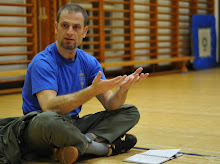After my Kung Fu years, I trained in Filipino martial arts and Judo, so stretching was never a serious part of my training - what I did was spend maybe thirty seconds stretching a muscle that felt "kinda tight" and that was it. So, the other day I was reading an excllent book on sports conditioning methods (High-Performance Sports Conditioning, edited by Bill Foran, published by Human Kinetics) that included one chapter on Performance Flexibility, written by Nikos Apostolopoulos, director of the Serapis Therapy Clinic in Canada, the only clinic in the world pioneering the development of therapeutic stretching. In that chapter I found tons of interesting information I wish I had known earlier, so I thought I'd share some of it with you:
On why you should stretch:
"Proprioceptors in the muscles, tendons, and joints, which sense muscle length, tension and joint angle, are critical in providing information to the motor system. Therefore, flexibility enhances the development of coordination and technique and the ability of proprioceptors to receive stimuli".
"Proper flexibility training can moderate, or even delay for many years, the deterioration of range of motion that occurs with age".
"Done at low intensity, static stretching and micro-stretching develop the flexibility reserve, decrease the influence of hypertrophy and other muscular changes during the development of strength, and decrease muscle tension, thereby increasing circulation and neural conductivity. This decrease in muscle tension also assists in decreasing muscle tone and aids the removal of metabolic wastes (i.e. lactic acid)".
On how you should NOT stretch:
"When the athlete performs a stretch and feels the muscles burning or senses an extreme pull in the muscles, that is a strain... A strain results in microtears of the muscle near the muscle-tendon junction. Microtears are microinjuries. The body responds to these tears by releasing collagen in the area, resulting in the development of scar tissue. As scar tissue ages it contracts, further tightening the surrounding tissues. These microtears [...] are located in the area of transition between elastic (muscle) and inelastic (tendon) tissue. In contrast to the middle of the muscle belly, this area has poor circulation, which is further diminished with the development of scar tissue. Therefore the repair process is slower".
On how often you should stretch:
"...An athlete must stretch at least twice a day to improve flexibility. The athlete must stretch each muscle group at least three times per session".
On how intensely you should stretch:
"Performance flexibility stretching is always done at a low intensity level (approximately 30 to 40 percent of perceived exertion). At this level, stretching increases the pliancy of the connective and muscle tissues".
"While stretching it is critical to avoid strain or pain, which would result in the activation or constant maintenance of a subconscious protective loop. The body maintains this loop to respond to an injury. Its activation results in the development and reinforcement of muscle imbalances and a further decrease in the range of motion around a joint".
On how long you should hold a stretch:
"The optimum length of time to hold a stretch is approximately 60 seconds. It normally takes about 30 seconds for a stretch to progress from the middle of the muscle belly to the tendons".
"... Individuals who hold a stretch longer than 90 seconds often complain of feeling tighter".
Highly recommended (available from www.humankinetics.com):







